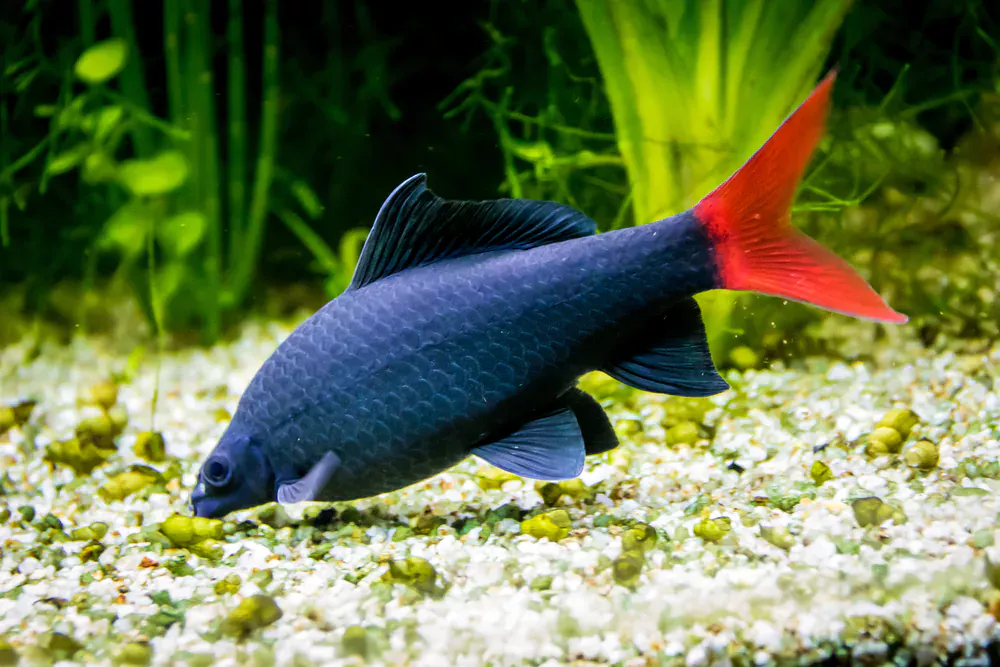Many people think that keeping a freshwater shark pet in an aquarium is difficult. In fact, some people, simply don’t believe that it can be done because of their size and behavior.
So let’s deep dive into it and see if it is possible to keep small tank sharks as a pet?
- 1 Can You Put a Shark in a Fish Tank?
- 2 What Kind of Shark Can You Put in a Fish Tank?
- 3 Is Aquarium Shark and Sea Shark Same?
- 4 What Size Are Freshwater Sharks?
- 5 Which is the Smallest Shark For Fish Tank?
-
6
17 Best Small Shark for Fish Tank
- 6.1 1- Bala Shark
- 6.2 2- Albino Rainbow Shark
- 6.3 3- Glo Sharks
- 6.4 4- Flying Fox Shark
- 6.5 5- Silver Apollo Shark
- 6.6 6- The Catshark
- 6.7 7- The Wobbie Shark
- 6.8 8- Epaulette Shark
- 6.9 9- Chinese High-Fin Banded Shark
- 6.10 10- Iridescent Shark
- 6.11 11- Black Sharkminnow
- 6.12 12- Red Tail Shark
- 6.13 13- Rainbow Shark
- 6.14 14- Violet Blushing Shark
- 6.15 15- Columbian Shark
- 6.16 16- Roseline Shark
- 6.17 17- Harlequin Shark
- 7 How to Set Up a Shark Aquarium?
- 8 What Size Tank Does a Shark Need?
- 9 Filtration and Water Requirements For Aquarium Shark
- 10 What Do You Feed a Pet Shark?
- 11 How Much Do You Feed a Shark?
- 12 Final Advice
Can You Put a Shark in a Fish Tank?
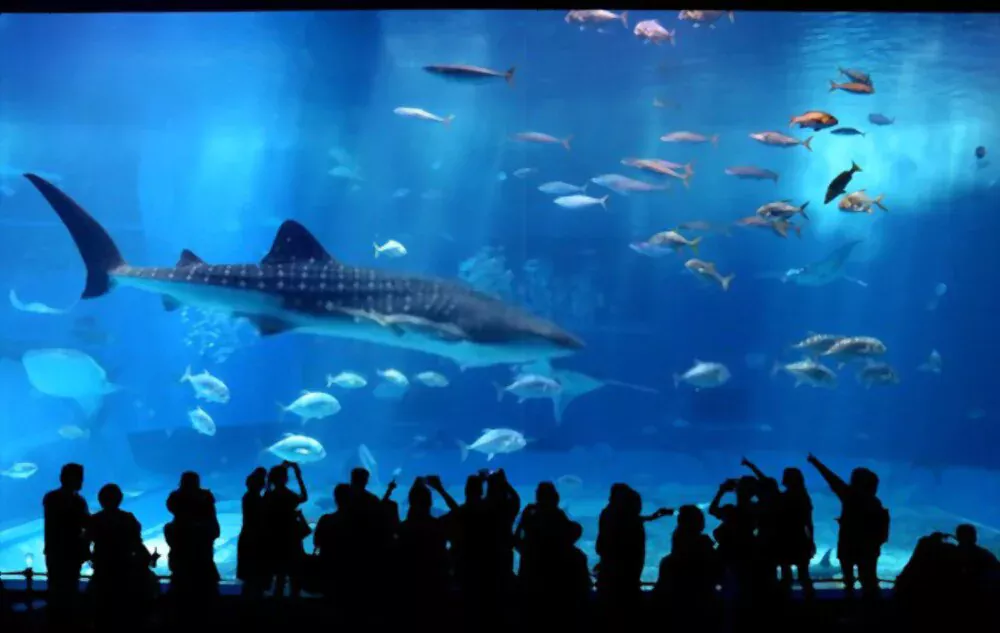
The short answer is yes, But when it comes to keeping freshwater aquarium sharks at home, most species are either too large, require too much space, or are not suited for life in captivity. However, many shark species are capable of living in an aquarium.
It’s important to understand a majority of sharks require a very large habitat with lots of room to swim, and this makes having them as pets somewhat difficult. But there are some tiny pet sharks most suitable for home aquariums.
What Kind of Shark Can You Put in a Fish Tank?
According to the Florida Museum of Natural History Ichthyology Department, some of the best small shark for fish tank are:
- Bala Shark
- Epaulette Shark
- Iridescent Shark
- Apollo Shark
- Glo Shark
- The Catshark
We will discuss them in detail later in this article.
Is Aquarium Shark and Sea Shark Same?
They are both sharks and they are often confused with each other, but they are not the same.
The main difference is that aquarium shark species are found in freshwater while sea shark species are found in saltwater.
Both types of sharks can be kept in an aquarium. Aquarium sharks need special care. They have to be fed at least twice a day. They also have to have a large tank with plenty of room to swim around in.
Sea sharks need even more care than aquarium sharks. They can’t survive for long periods without water so their tanks must be cleaned regularly and filled with fresh water several times a day.
In conclusion, both types of sharks can be kept as pets, but you need to take good care of them or else they will die very quickly.
What Size Are Freshwater Sharks?
Aquarium sharks are generally smaller species, mostly less than 3 feet long, but there are some exceptions.
Sea sharks are generally larger species, up to 40 feet long, but again, there are some exceptions.
Which is the Smallest Shark For Fish Tank?
The smallest shark for fish tank is the Flying Fox Shark, which can grow up to 8 inches (20 cm) in length.
Some also consider the Bala Shark (Etmopterus perryi) to be the smallest shark for fish tank, which can grow between 8 to 12 inches in length.
In fact, there are many species of shark that can comfortably live in an aquarium. A few of them are discussed below.
17 Best Small Shark for Fish Tank
If you have decided to have a shark, then you are probably considering a small shark for fish tank. While there are a lot of different species to choose from, it is important that you choose the right one. Therefore, we have compiled a list of the 17 best small shark for fish tank.
1- Bala Shark
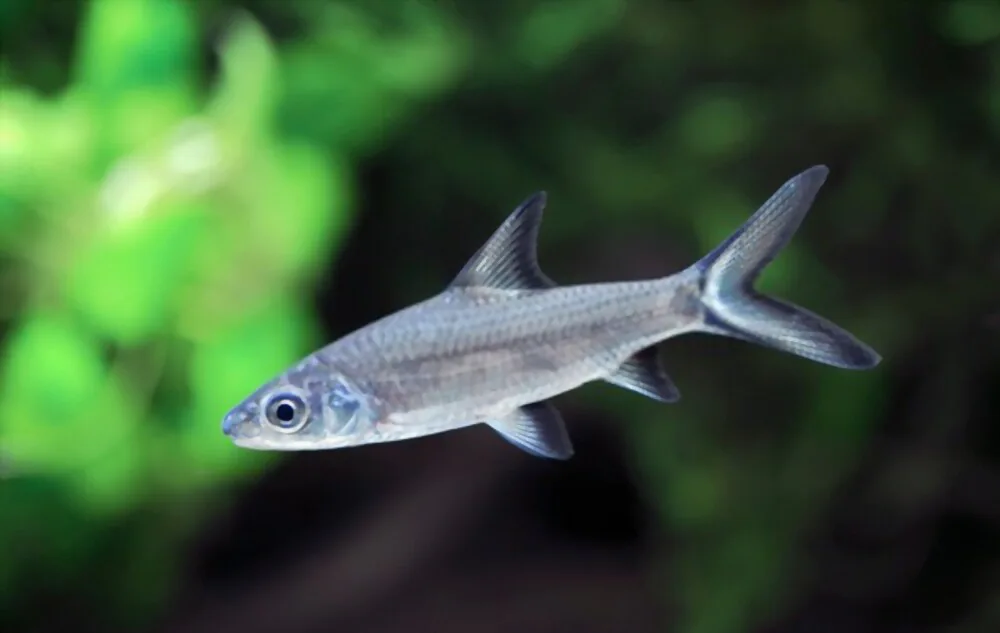
Bala sharks are the most common type of shark in home aquariums. They are also known as Silver Sharks, Tricolor Sharkminnows, and Tri-color Sharks. The scientific name is Balantiocheilos melanopterus. They occur in the Mekong river basin, Chao Phraya River basin, and Malay Peninsula. These fish are native to Thailand, Cambodia, Vietnam, and Malaysia.
In their natural habitat, these fish can reach a maximum length of about 31cm (12 inches). But when kept in aquariums they usually grow to about 20cm (8 inches). A Bala shark will live for about 8 years if it is kept in a suitable environment and provided with the correct care.
They may also be sensitive to water conditions and should not be housed in tanks with a pH level lower than 7.0 or with high amounts of chlorine in the water.
2- Albino Rainbow Shark
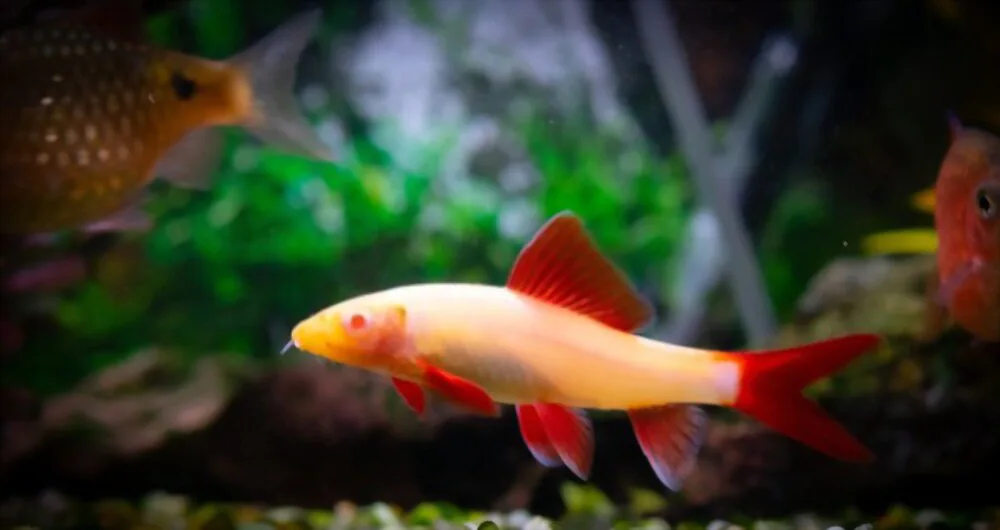
The Albino Rainbow Shark is a lively and active fish with an elongated body, a small dorsal fin, a large tail fin, and a blunt head.
Albino Rainbow Sharks are very beautiful and can add a lot of life to your aquarium. They are also very easy to take care of as long as you keep them in the right environment. Make sure that they have everything they need to live a long, happy life.
Albino Rainbow Sharks have a lifespan of between 5 and 10 years and can grow up to 5 inches long. They are known for being hardy fish, which makes them ideal for beginners. As long as they’re kept in the right environment, they can tolerate a variety of water conditions and temperatures. Their diet consists of omnivorous foods such as flakes or pellets, vegetables like cucumber or zucchini, shrimp, and other meaty foods like bloodworms or brine shrimp.
3- Glo Sharks
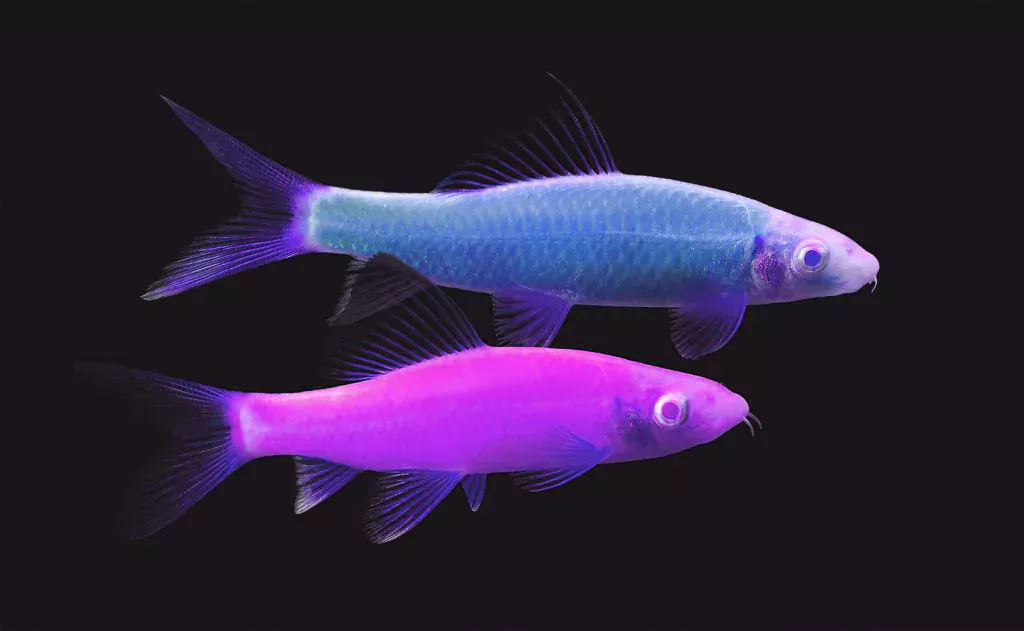
Glo sharks (also known as Glofish) are a unique species of fish that were developed and patented by Yorktown Technologies in 1999. The company’s team of genetic engineers spliced fluorescent proteins with the genes of tropical fish, such as Zebra Danio and Tiger Barb.
Their goal was to make colorful saltwater fish for the aquarium trade, but the project evolved into a study about gene activation and expression in living organisms.
There are three types of Glo fish: red, green, and orange. These species have been approved for sale in the United States by the FDA but are not allowed in Texas or California.
The maximum size of Glo sharks is close to two inches (around 5 cm). They can live up to three years in captivity if properly fed and housed.
I recommend using the soft substrate, coarse ones will harm their bodies. And keep the water temperature between 68°F-77°F (20°C-25°C) for a longer lifespan.
4- Flying Fox Shark
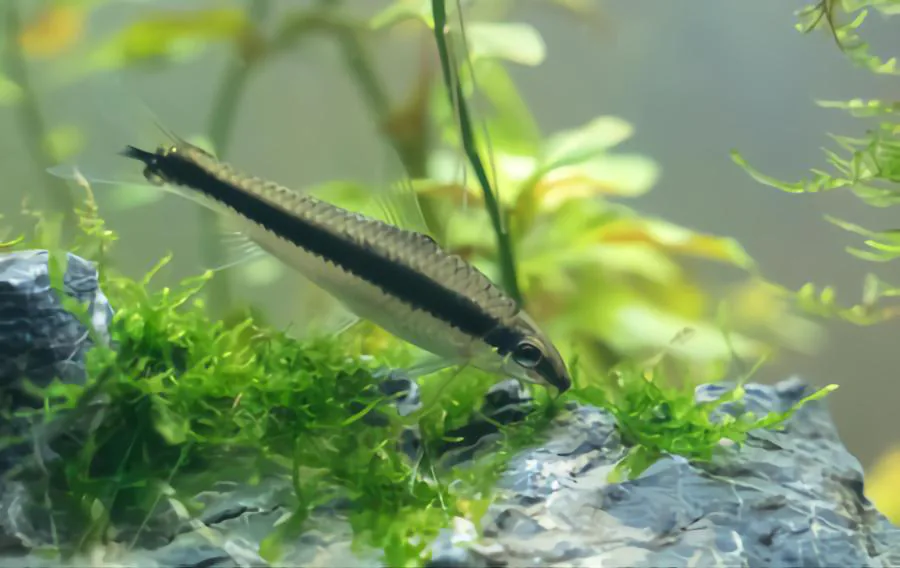
The Flying Fox Shark (Epalzeorhynchos kalopterus) is a very beautiful and peaceful fish. This is one of the rarest species in the hobby, but it is worth every penny.
This fish has a golden brown base color with black stripes/spots over it. It can also change its color to adapt to the environment. It has a longer nose than any other Epalzeorhynchos species. It is also known as the Siamese flying fox, and many people confuse it with Epalzeorhynchos frenatum or the red finned shark. The Flying Fox Shark is an omnivore and will eat anything including algae wafers, tropical flake food, and brine shrimp.
The Flying Fox Shark can grow up to 6 inches in length in aquariums, but they can reach up to 8 inches in their natural habitat. They have a lifespan of 5 years in aquariums while they have a lifespan of 10 years in their natural habitat.
The Flying Fox Shark is a schooling fish that should be kept in groups of at least three. They will not harm other fishes but may nip at the fins of long-finned species such as angelfish. Because of their diet and growth rate, they are not suitable for small tanks and should be kept in tanks 55 gallons or larger.
5- Silver Apollo Shark

The Silver Apollo Shark is a beautiful specimen of freshwater fish. They are best known for their appearance, as they have black and white bands that circle around the body. These bands also follow the fins, but they are not visible in the belly area.
The Silver Apollo Shark has a large head with a wide mouth and two barbels. The size of these barbels depends on their age, as they become larger as the fish ages. But they can reach up to 15 inches in length. They also have three dorsal fins and an anal fin to help them swim in their environment.
The Silver Apollo Shark can live for up to 12 years if you provide it with the proper care.
When you purchase your fish from a pet store or online, it is often between 3 and 5 inches in length. However, as I mentioned earlier, these fish can grow to be up to 15 inches long. This means that they need a lot of space because they do not like to be cramped together in an area with other fish. You should ensure that your aquarium is large enough for your shark to live comfortably. They need at least a 30-gallon tank, but you might want to go bigger if you have more than one shark swimming around.
6- The Catshark
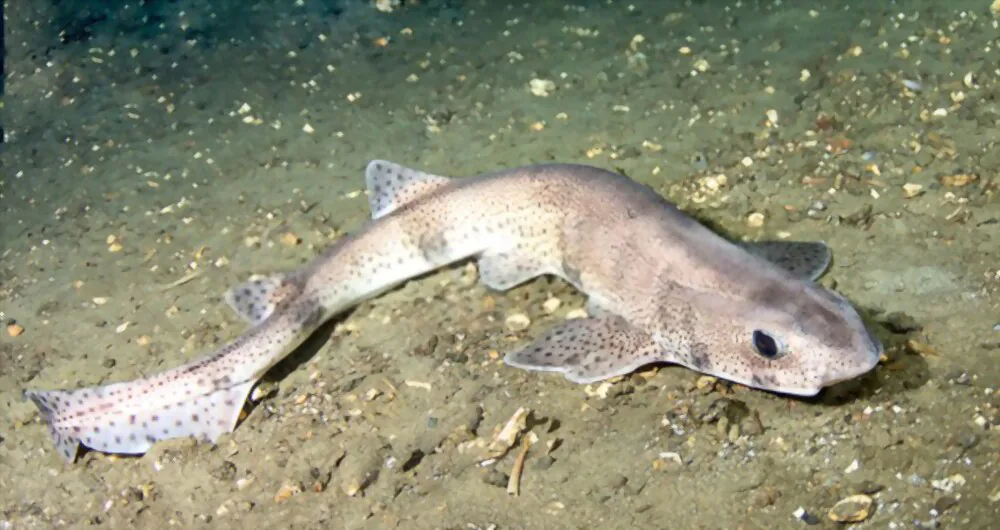
Catsharks are a large group of bottom-dwelling sharks in the family Scyliorhinidae. The Catsharks have an oval body and a small head. They have small eyes, high fins, pointed snouts, and long tails. Most of them are brown or grey in color but some are colorful.
The Catshark is one of the easiest sharks to keep in an aquarium. It’s also one of the smallest, which makes it a good choice for a beginner. The lifespan of these sharks ranges between 10 and 20 years, but this depends on the size of the aquarium and the quality of care.
The Catshark has a unique look when compared to other sharks. Its body is more angular than most sharks and its coloring is a bit brighter. It’s also a unique shape when you compare it to other sharks. The Catshark has a wider head and body than most sharks, which gives it a more rectangular shape.
The Catshark is not very active, so it can often be found sitting on the bottom of your tank or swimming very slowly through the water. The Catshark typically only reaches lengths of up to 16 inches long, making them shorter than most other species of shark, but they have thick bodies that are very heavy in comparison to their length.
7- The Wobbie Shark

The Wobbie Shark is a fish native to Indonesia and Malaysia. It is commonly known as the wobbegong, carpet shark, or shark-net (the latter in Queensland). When it was first discovered, scientists thought it was an eel because of its flat body. This kept them from placing it in the same family as other sharks for a long time. They were wrong.
The wobbie shark can grow to a maximum length of 80 cm (2.6 ft) but usually has an average length of 60 cm (2 ft). The oldest recorded wobbie shark was 16 years old but they can live up to 10 years in captivity. They are oviparous and they reproduce by laying eggs where one female can lay 2-3 eggs in every breeding season.
The wobbie shark requires a large tank because it is a large fish that grows to about 80 cm (2.6 ft) long as mentioned earlier. A tank size of about 260 liters (70 US gal) with a sand substrate should be provided for this fish because it prefers to have its body buried in the sand during the daytime when it is inactive and at night they love to swim around.
8- Epaulette Shark
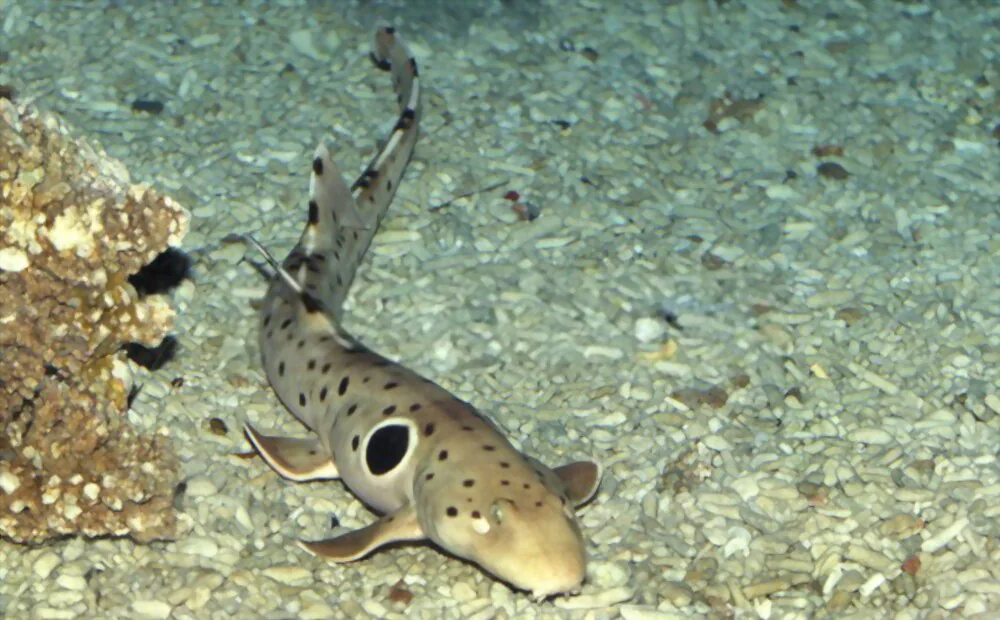
The Epaulette Shark is a small, docile species of shark that is found in shallow waters of the Indo Pacific. It is named for the two dark spots on each side of its body, which resemble an epaulette, a shoulder ornament worn by military officers.
The average life span for the Epaulette shark is about 15 years when kept in captivity. The Epaulette shark will grow to a maximum length of about 24 inches. Male sharks are generally smaller than female sharks.
The best aquarium environment for the Epaulette shark is an environment with plenty of live coral rock, lots of hiding places, and many caves to swim in and out of. The water temperature should remain between 72 and 78 degrees Fahrenheit at all times along with a pH level that stays between 8.10 and 8.40.
9- Chinese High-Fin Banded Shark
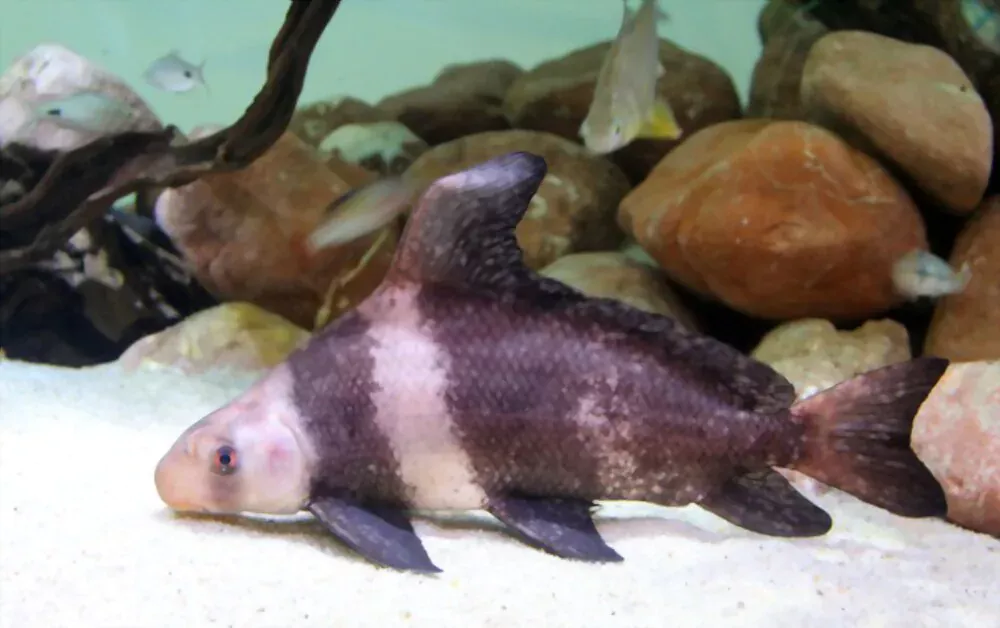
The Chinese High-Fin banded shark is also known as the bronze shark, copper shark, or shark catfish. They are a type of freshwater fish that is relatively peaceful and can be a good community fish.
Chinese High-Fin Banded Sharks are very unique, beautiful freshwater fish that can reach up to 30 cm (12 in) in length but they usually grow to 20 cm (8 in). Male Chinese High-Fin Banded Sharks have larger dorsal fins than females. The life span of the Chinese high fin banded shark is around 5 years in the wild and 8 years under proper aquarium conditions.
Chinese High-Fin Banded Sharks are often added to community aquariums along with other fast swimming cyprinids or barbs as they are very active fish. The tank should be big enough to provide ample swimming space for all tank mates as well as tall enough to accommodate the growth of the dorsal fin.
10- Iridescent Shark
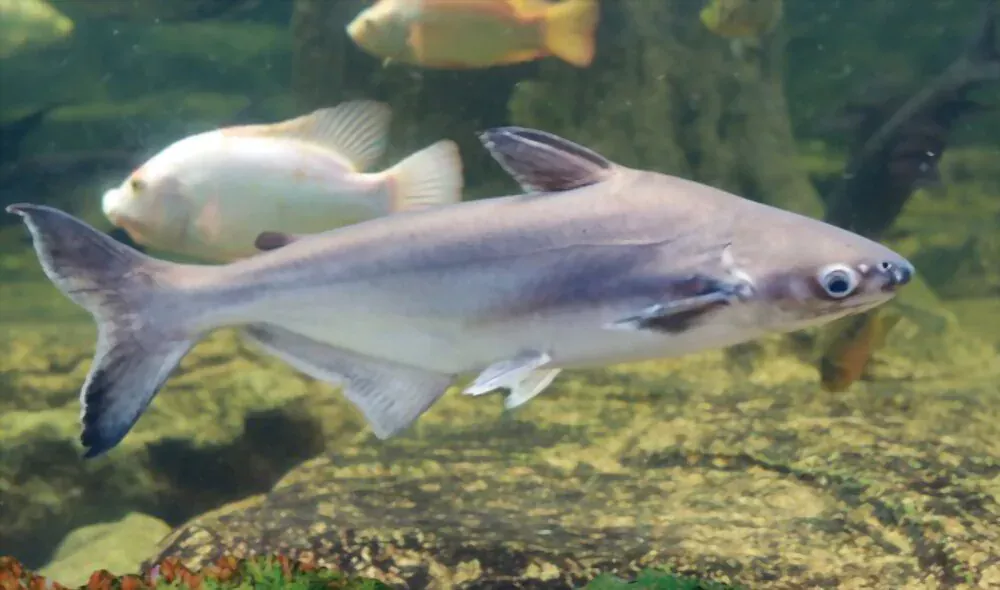
Iridescent Shark (Pangasianodon hypophthalmus) is a freshwater fish found in the Mekong basin in Southeast Asia and is commonly kept in home aquariums. The Iridescent Shark is also known as the Sutchi Catfish, Striped Catfish, or Swai. Most Iridescent Sharks are farm-raised for human consumption but are also found in the wild.
The shark gets its name from the iridescence of its scales, which give the appearance of a wet surface and sparkle with color when exposed to light. They can vary in color according to their environment, with greenish sides and belly, brownish back and fins, and a gold iridescence on their body.
Iridescent Sharks are fast-growing fish that reach a maximum size of around 42 inches (107 centimeters), although they are more often around 25 inches (63 centimeters). In captivity, they have been known to live up to 15 years.
These sharks are social animals that prefer to live in groups of four or more. They will become aggressive when kept alone, which can lead to health problems such as stress-related diseases or even death from depression. The best environment for them is a large tank with plenty of hiding places like rocks or plants where they can retreat if there’s danger nearby.
11- Black Sharkminnow
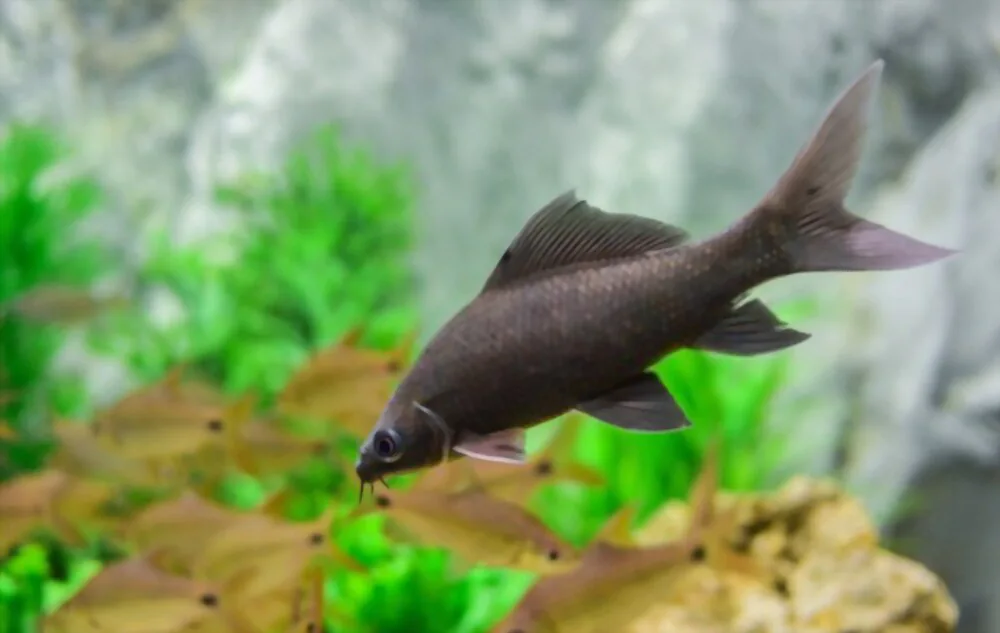
The Black Sharkminnow is a rare and beautiful small fish native to the streams and rivers of Southeast Asia. The black sharkminnow was first introduced to the aquarium hobby in 2012 by Aquarium Glaser GmbH, a German-based company that specializes in breeding rare species.
Black Sharkminnow, also known as the Black shark, is a popular freshwater fish species with its origins in South Asia. It belongs to the Cyprinid family and is famous for its black body color.
The black shark grows to an average size of around 20cm (8 inches) in length. However, they can grow bigger than that under suitable conditions. The average lifespan of a black sharkminnow is 2-5 years if kept in captivity. This lifespan and size may vary depending on several factors including diet, tank size, and water quality.
12- Red Tail Shark
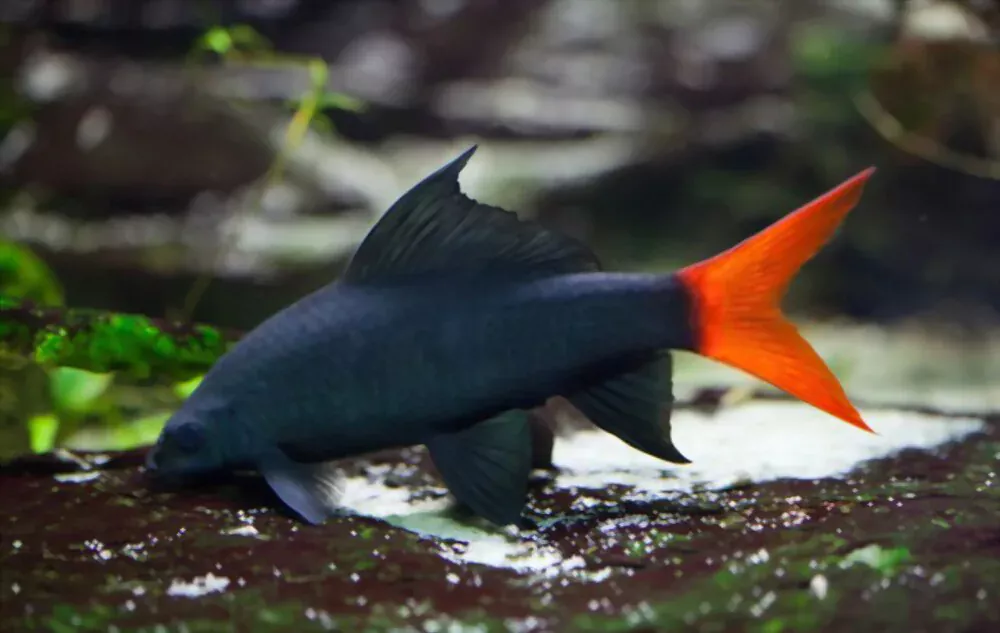
Red Tail Sharks are a type of catfish that are very popular in aquariums. They get their name from the red coloration on their tail, which is one of the most striking features of this species.
These fish are not true sharks and there is no relationship between the Red Tail Shark and the real sharks in the ocean. While they have the word shark in their name, these fish do not have any of the physical characteristics of an actual shark at all.
The Red Tail Shark is a freshwater fish native to Thailand and they prefer slow-moving waters with plenty of plants and rocks around. In their natural environment, they can grow to be up to 12 inches long, but when kept in an aquarium they tend to top out at about half that size.
Redtail sharks are very intelligent and active fish that like to explore their environment. They even recognize the owner. The Red Tail Shark usually lives for about five to seven years in captivity, with some specimens reaching ten years in captivity.
The species are omnivorous and will primarily feed on zooplankton, insects, and algae, but will consume vegetation including fruits, leaves, roots (mostly rhizomes), tubers, and seeds when available.
13- Rainbow Shark
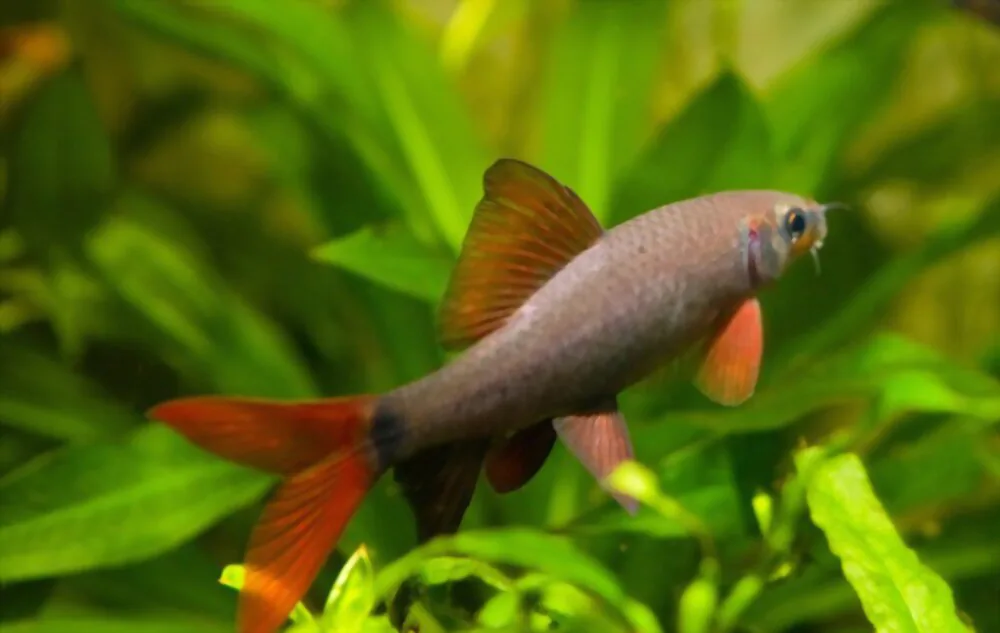
Rainbow Shark is one of the most popular aquarium fishes, which is famous for its bright red fins. This fish originates from Thailand and South China. It inhabits Mekong, Chao Praya, and other rivers that flow through the territories of Thailand, Vietnam, and Laos. The species has been formed artificially in the USA for decorative purposes.
The lifespan of a Rainbow Shark is usually around 8 years. As far as size goes, they generally grow up to 6 inches (15 cm).
The best aquarium environment for Rainbow Sharks is in a 30-gallon (114 liters) or larger tank that is well planted in order to allow enough swimming space between the plants and other decors. A sandy substrate and ample rocks or driftwood should also be provided to help create hiding places along the bottom of the aquarium.
Rainbow sharks are bottom dwellers, so make sure to have plenty of places for them to hide along the bottom of the tank. It’s best to keep Rainbow Sharks in groups of at least three or more, this will make them much less territorial. Although they are known to be slightly aggressive, they can coexist with other semi-aggressive species such as cichlids.
14- Violet Blushing Shark
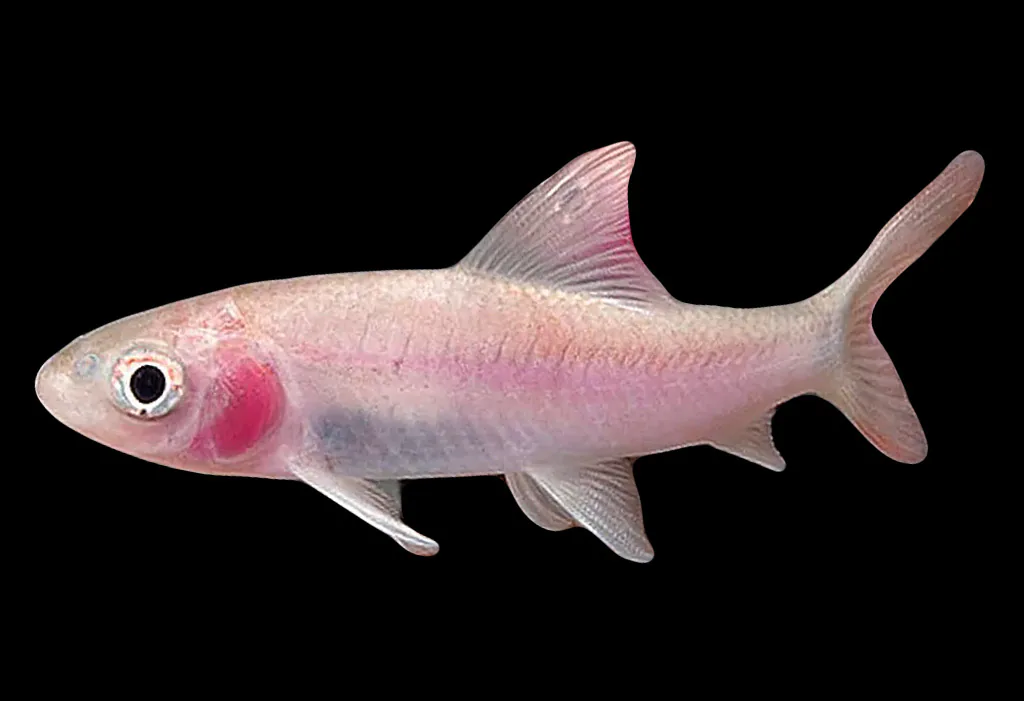
The Violet Blushing Shark is a distinctive-looking fish that has a luscious violet body and bright red fins. They are easy to care for freshwater sharks but need a large aquarium of at least 50 gallons in order to give them the room they need to grow. These fish will put on quite the show in your aquarium, as they dart around, then stop on a dime in front of you to see what you’re doing. They are also very gentle and peaceful towards other tank mates and plants.
Because these fish are so active and curious, they do best with plenty of open swimming space and plants that won’t get trampled by their constant swimming activity. You can keep them with other similarly sized fish, but they do well on their own in smaller groups or pairs. If you think you have enough space in your home or office for one of these beautiful creatures, you should definitely give this one a try.
Violet blushing sharks can attain a maximum length of about 8 inches with an average lifespan of 8 years. However, most captive specimens remain much smaller than this, often reaching only 4 – 5 inches in length.
15- Columbian Shark
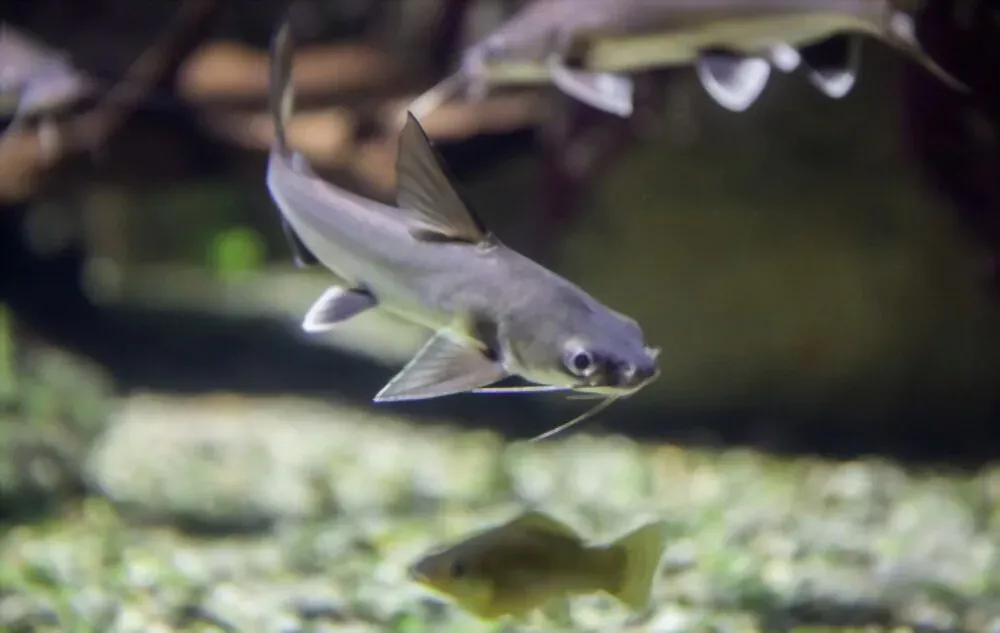
Columbian sharks are great freshwater fish for an aquarium. They are easy to keep and can be kept with other fish species. It’s best to keep them in groups of at least five. You should also give them plenty of space for swimming and hiding places.
Columbian Sharks can also be kept with other types of fish, such as catfish and cichlids. However, they may eat some of the other fish, so you should take that into account when picking tank mates for them.
The Columbian Shark can grow quite large (up to 60 cm) with an average lifespan between 10 to 15 years. so it’s important to give them enough space to live comfortably in their new home. You should get a tank that’s at least 55 gallons for one or two of these sharks. If you plan on keeping more than that, then you need a larger tank!
16- Roseline Shark
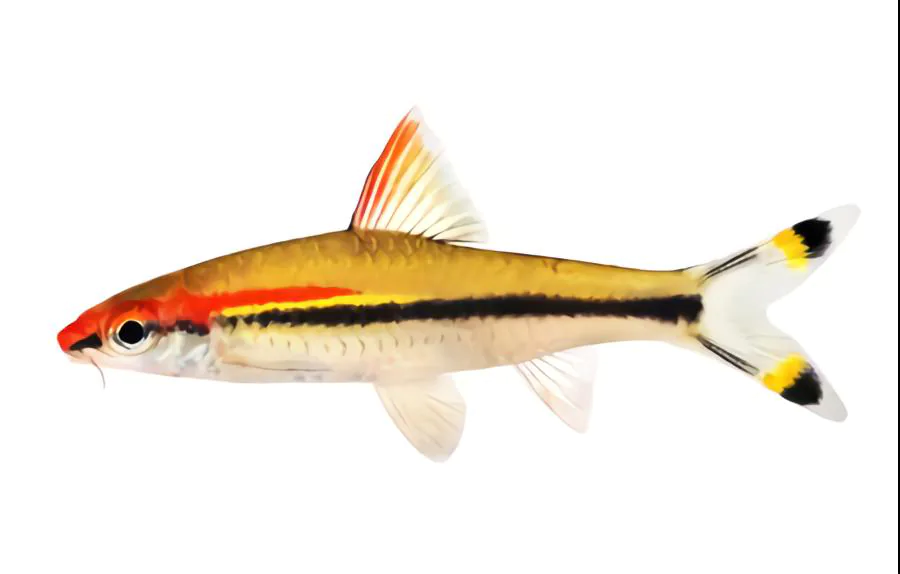
Roseline Shark is a popular freshwater aquarium fish that is also known as the Red-Finned Shark and the Red-Lined Torpedo Barb. It is a member of the Cyprinidae family of freshwater fish. They are native to India and Sri Lanka.
Roseline Shark has an elongated body with a low dorsal fin, which runs along its back. This type of fish has bright orange-red coloration on its fins, head, and tail. The body itself is white with a silver sheen.
The lifespan of Roseline shark fish is 3 to 7 years, but it may live longer if kept in appropriate conditions. The Roseline Shark can reach a maximum length of 5 inches, with females being slightly larger than the males.
The Roseline Shark is an active schooling fish that does best in a group of 7 or more. The minimum tank size for a school should be 100 gallons or larger, but larger is better as they will be happier, less aggressive towards each other, and have more room to swim around.
They do best in tanks that have lots of plants, rocks, and places to hide. The addition of driftwood would also be beneficial to them, along with some live plants that can grow against driftwood and rocks. They are known to nibble at live aquarium plants so you may want to avoid or replace those that they eat too much off.
17- Harlequin Shark
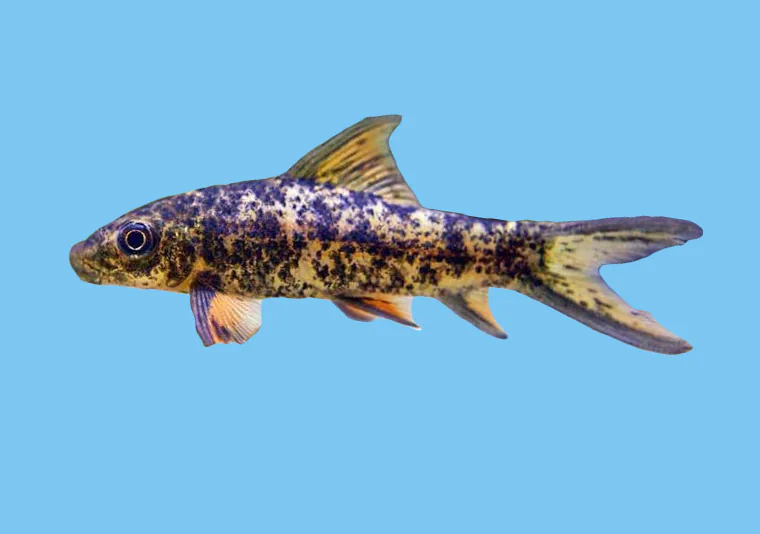
The Harlequin shark is a unique and extraordinary small shark species. The large eyes and bright patterns make them quite visually appealing. Due to the high price, they are not as commonly kept as other freshwater sharks.
The Harlequin shark can grow up to 1.5 feet in length. They typically live 6 to 8 years in captivity, with a few specimens reaching 10-15 years of age.
In the wild, they are known to inhabit the reefs at depths of up to 100 meters, and they prefer sandy or muddy bottoms. They feed on crabs, mollusks, and other small fish.
The best aquarium environment for Harlequin Shark is one with a temperature range between 16°C and 24°C. The tank should have a large sand bed for it to bury itself in during the daytime, as well as plenty of rocks that it can hide in when resting or sleeping at night.
How to Set Up a Shark Aquarium?
As with any aquarium, setting up a shark tank is a long and complicated process. You’ll need to select the right equipment and ensure that it is properly maintained. You’ll also need to make sure that you have the time and space for the proper care of your shark.
Below are a few things to keep in mind before you introduce your shark to the aquarium.
- Fill the tank with 78 degrees F water. Use a heater to maintain the temperature if necessary.
- Add aquarium salt at the rate of 1 tablespoon per 5 gallons of water, and let it dissolve completely.
- Put the sharks in the tank after acclimating them for about 20 minutes.
- Place rock formations in the tank and add plants and sand or gravel to decorate it.
- Set up your filtration system and powerhead to keep the water clean and well-circulated, adjusting them as necessary so that they don’t disturb the sharks when they are resting on the bottom of the tank.
What Size Tank Does a Shark Need?
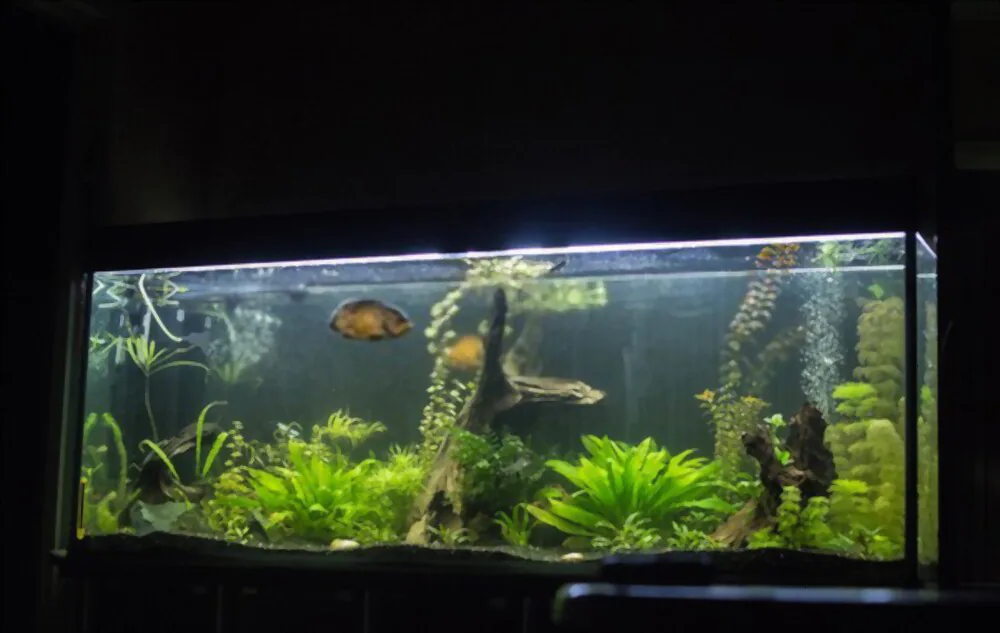
Sharks are active swimmers and require plenty of room to move around freely. For most aquarium sharks, a minimum tank size of 55 gallons is recommended for one shark, with an additional 20 gallons required for each additional shark added to the tank.
But please keep in mind, that there are a few exceptions to it. Few sharks require a lot of space (300-500 gallons) depending on their size. So always take help from a pet store or specialist before buying one.
And the tank should also be set up with plenty of caves, rocks, or driftwood structures which will allow the sharks to hide when they feel threatened or unsafe in the open water.
Filtration and Water Requirements For Aquarium Shark
When choosing a filter system for your shark aquarium it is important to select one that provides plenty of mechanical filtration in addition to biological filtration.
Mechanical filtration helps keep particles such as food bits and waste out of the water, while biological filtration provides a habitat for beneficial bacteria that help convert ammonia into nitrites, which are much less toxic than ammonia.
Many different filter systems are now available, such as power filters, protein skimmers, and canister filters.
Power Filters
Power filters are the simplest and least expensive systems and provide a good mechanical filter.
Protein Skimmers
Protein skimmers, such as those made by Marineland, provide a chemical process that breaks down organic waste into small particles that can be more effectively absorbed by biological filtration.
Canister Filters
Canister filters are the most complex of the three types because they require high-end plumbing to use in a saltwater aquarium. Canister filters push water through a series of rotating chambers where waste is broken down and can be easily removed by a filter sock; they provide the finest filtration available.
What Do You Feed a Pet Shark?
The answer is: pretty much anything.
“If they’re a fish-eating shark, you can feed them fish. If they’re a meat-eating shark, you can feed them meat,” says Jim Gelsleichter, a marine biologist at the University of North Florida who has studied and kept sharks in captivity for decades.
Moreover, you can also feed your shark with pellets. Sharks that swim at the bottom of the tank will feel more at home with sinking pellets placed on the bottom of the tank. These foods sink to the bottom as they are eaten, so your shark can easily find its next meal.
The best treats for sharks vary in content but should include a mixture of high-protein live or frozen foods as well as vegetable products.
How Much Do You Feed a Shark?
Feed a shark too much, and it will die from the disease. Feed a shark too little, and it will die from starvation. It is challenging to know exactly how much food to feed a shark based on its size, species, and current weather conditions.
If you go by the generally accepted wisdom among aquarists, it’s roughly 3 to 5 percent of its body weight per week. That’s not an enormous amount of food. You can eyeball a shark and estimate its weight and therefore how much you need to feed it.
But if you find it difficult to estimate the weight of your pet shark, just feed the amount of food that they can consume in about 2-3 minutes and you will be fine.
Final Advice
With all the popular freshwater aquarium sharks now in front of you, it’s time to take some time and figure out which ones you are most interested in.
No matter what your experience level is, there should be a pet shark that is perfect for you. Some of them might be too large to consider for your home setup but most of the smaller sharks on this list are totally suitable for small aquariums.
The larger your pet shark is the more waste it will produce. As long as you provide a good filtration system that can help to reduce the amount of waste your pet produces, there are high chances your shark will have a longer lifespan.
Please let us know in the comment which one in the list you like the most.

